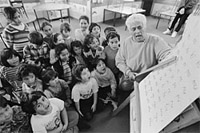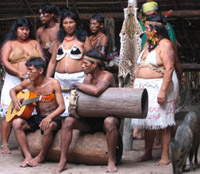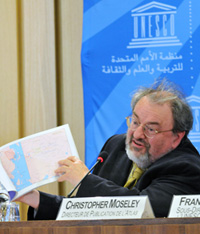Each language is a uniquely structured world of thought

- © Alexander Turnbull Library
- A « language nest » where the Maori language is passed on to children (New Zealand)
Australian linguist Christopher Moseley explains the crucial importance of preserving languages and presents the main innovations of the just-released third edition of the “UNESCO Atlas of the World's Languages in Danger”.
Interview by Lucia Iglesias (UNESCO)
Why should we care about language preservation?
We as human beings should care about this in the same way we should care about the loss of the world’s variety of plants and animals, its biodiversity. What is unique about present-day language revival movements, which didn’t exist before, is that linguists are for the first time aware of just how many languages there are in the world, and are coming to a better understanding of the forces that are attacking them and exterminating them, and of ways to control those forces. It’s very difficult and complex, and it would be naďve and oversimplifying to say that the big ex-colonial languages, English or French or Spanish, are the killers, and all smaller languages are the victims. It is not like that; there is a subtle interplay of forces, and this Atlas will help ordinary people to understand those forces better.
But to answer in one sentence: why do we have to care? Because each language is a uniquely structured world of thought, with its own associations, metaphors, ways of thinking, vocabulary, sound system and grammar – all working together in a marvellous architectural structure, which is so fragile that it could easily be lost forever.
Can you tell us a few projects or initiatives you know that have helped to safeguard a language?

Projects and initiatives exist at all levels – from local grassroots campaigns from the bottom up to get people to read in their own language and thus pass it on to younger generations, up to big state–supported plans.
In Australia, for instance, there are active and successful campaigns to revive the use of languages that were regarded as dead for generations, but turned out to be only ‘sleeping’. In New Zealand, the Maori language has been rescued from near oblivion through the scheme of ‘language nests’ – nurseries where the language is passed on to young children.
But the biggest success stories are the ones that are operated with state support and infrastructure, such as the reclaiming of Welsh in Wales or Catalan in Catalonia – two regions of Europe that have seen success in our own lifetimes – or, of course, the revival of Hebrew as a national language in Israel.
What is new in this edition of the Atlas?
This third edition of the Atlas is new in at least three important ways. Firstly and most obviously, it is being published in two different formats: an on-line version as well as a printed version. The on-line version is an important new development, and is based on Google Earth maps, with the location of each endangered language, no matter how small, pinpointed as exactly as possible on the maps, which can be filtered to any desired scale and level of detail.
Secondly, for the first time we are giving a comprehensive coverage of the whole world. The previous two editions gave only a sample from some continents of the state of threatened languages, but this time we have been careful to cover every language, and, as before, to show the level of endangerment, from “Unsafe” down to “Moribund” with a system of colour coding.
And thirdly, we are making the Atlas available in three languages: English, French and Spanish, with possibly more translations to come later.
You are the general editor of the Atlas. Can you explain how the work for this Atlas was done?

It was a worldwide collaborative effort by a team of linguists, all of them experts in the field of endangered languages and linguistics. As in the previous editions (published in 1996 and 2001), we had Regional Editors in charge of collecting data for each continent, writing the regional essays for the Atlas, and entering the language points in the maps.
For some areas, local knowledge of the situation came from specialists in several countries. Of course the contributors needed help and guidance from technical experts at the Section for Intangible Heritage of UNESCO as well. The Web Editor from UNESCO provided help and guidance for the editors at every step of the way while the on-line version was being created, because this was a pioneering experiment for all of us; and meanwhile the commissioning editors and myself as general editor were overseeing the preparation of the texts. The whole project has been done to a tight schedule, in just under a year from start to finish.
Link for UNESCO Interactive Atlas of the World’s Languages in Danger
- 18-02-2009
- Photo 2 : © Jennilou & Jeff Grace - Amazonia (Brazil): indigenous languages are dying out today. Until the mid-18th century, Tuli, for one, was spoken as much as Portuguese
- Photo 3 : © UNESCO/Michel Ravassard - Christopher Moseley, Editor in Chief of the UNESCO Atlas of the World's Languages in Danger

